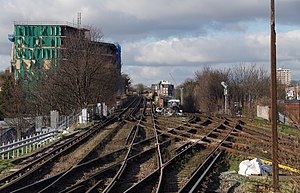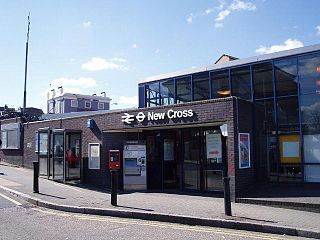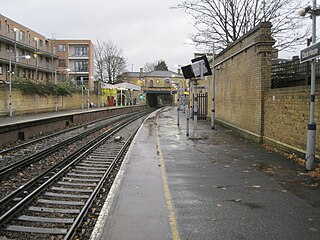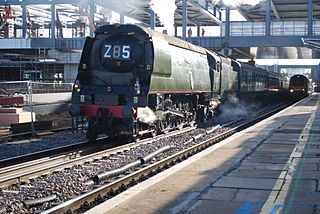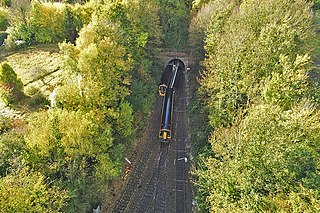On 2 March 2018, eleven passenger trains operated by Southeastern became stranded in the Lewisham, St Johns and New Cross area in weather conditions of snow and freezing rain. [2] Due to a lack of communication with passengers, a lack of heating and lack of toilets, passengers abandoned five of the nine trains. [9] The eleven trains involved comprised at least 22 electric multiple units. Two of the units had no toilets, and five of the remaining twenty-plus were operating with toilets that were not in service. [10] [2] Four people were treated for minor injuries. [11]
Timeline
- 17:34
Train 2M48 came to a stand after passing Lewisham station, unable to draw power as the third rail was affected by freezing rain. The train comprised two Class 465 and one Class 466 electric multiple units and was operating the 15:56 Charing Cross to Dartford service which had departed 67 minutes late and was running 80 minutes late when it came to a stand. [10] The units involved were 465 003, 465 164 and 466 024. [2]
- 17:38
Train 2M50 came to a stand approaching Lewisham due to 2M48 being at a stand ahead. The train comprised two Class 376 electric multiple units, which did not have onboard toilets. It was operating the 16:26 Charing Cross to Dartford service which had departed 47 minutes late and was running 54 minutes late when it came to a stand. [10] The units involved were 376 002 and 376 035. [2]
Train 2S54 came to a stand opposite St Johns station. It comprised three Class 465 units and was operating the 17:06 Charing Cross to Orpington service which had departed 17 minutes late and was running 17 minutes late when it came to a stand. [10] [2] The train came to a stand with its rear carriages blocking Tanners Hill Junction. [12]
- 17:41
Train 2R46 came to a stand between New Cross and St Johns. Train 2V07 came to a stand at St. Johns. [2]
- 17:44
Train 2H50 came to a stand near New Cross. The train comprised two Class 465 and one Class 466 units and was operating the 17:30 Charing Cross to Tunbridge Wells service which had departed on time and was running 1 minute early when it came to a stand. [10] [2]
- 17:45
Train 2H00 came to a stand approaching Tanners Hill Junction, which was blocked by train 2S54. [2]
- 17:50
Train 2S56 came to a stand west of New Cross. The train comprised two Class 465 units and was operating the 17:36 Charing Cross to Slade Green service which had departed one minute late and was running to time when it came to a stand. [10]
- 17:55
Train 2R48 came to a stand behind train 2S56. [2]
- 18:10
Train 2H02 came to a stand approaching the flyover at St Johns. [2]
- 18:16
Network Rail called out a Mobile Operations Manager (MOM) to de-ice the third rail and get 2M48 moving again. It was planned to terminate the train at Blackheath. Until 2M48 had been moved, other trains were unable to proceed, including 2M50, which was being held at a signal in sight of Lewisham station. [10]
- 18:28
An Automatic Warning System fault developed on 2M48. [10]
- 18:36
The MOM arrived on site. An emergency power isolation was made to the up and down North Kent Lines to enable the third rail to be de-iced. [10]
- 18:43
Train 2K43 became stranded at Lewisham station due to the emergency power isolation. [2]
- 18:45
The MOM reported that passengers had abandoned 2M50 and walking along the track to Lewisham station. [10] An emergency power isolation was made covering all lines between North Kent East Junction and School Junction, Blackheath Junction to Nunhead, Courthill Junction and Tanners Hill. [13] 2M50 had been at a stand for 67 minutes. [10]
- 18:50
Some passengers abandoned 2S56, which had been at a stand for 72 minutes. [10]
- 19:06
Some passengers abandoned 2M48, which had been at a stand for 92 minutes. [10]
- 19:15
More passengers abandoned 2S56. Not reported until 19:40 as the driver was dealing with a passenger who had been taken ill. [13]
- 19:32
Some passengers abandoned 2H50, which had been at a stand for 109 minutes. [10]
- 20:26
More passengers abandoned 2M48, which had been at a stand for 168 minutes. [13]
- 21:36
Current restored to area. [10]
- 21:54
Train 2M48 was able to proceed. [2]
- 21:57
Train 2M50 was able to proceed. [2]
- 21:58
Train 2S54 was able to proceed. [2]
- 21:59
Trains 2H00 and 2V07 were able to proceed. [2]
- 22:00
Train 2H02 was able to proceed. [2]
- 22:05
Trains 2K43 and 2R48 were able to proceed. [2]
- 22:16
Train 2H50 was able to proceed. [2]
- 22:23
Train 2S56 was able to proceed. [2]
